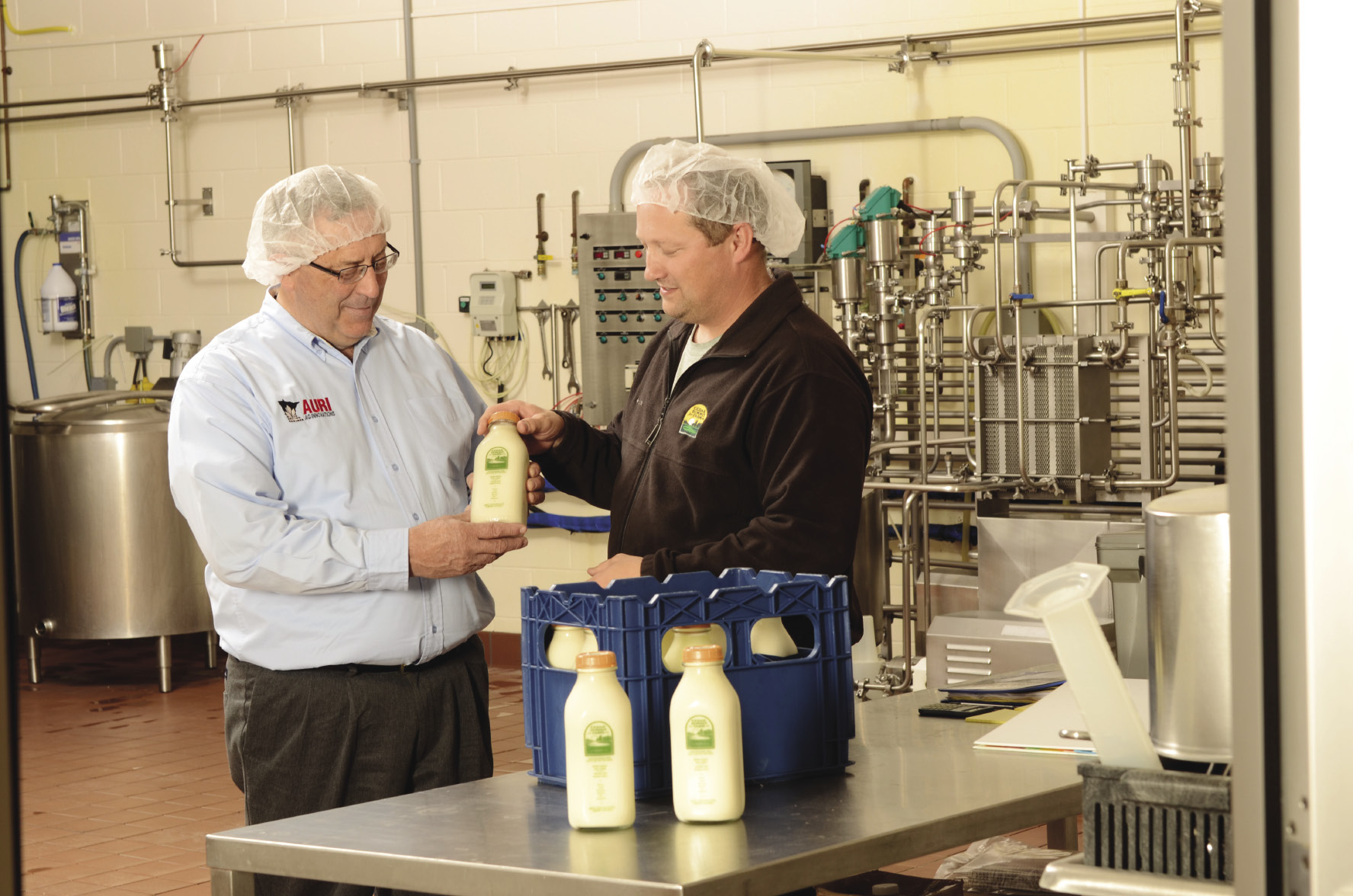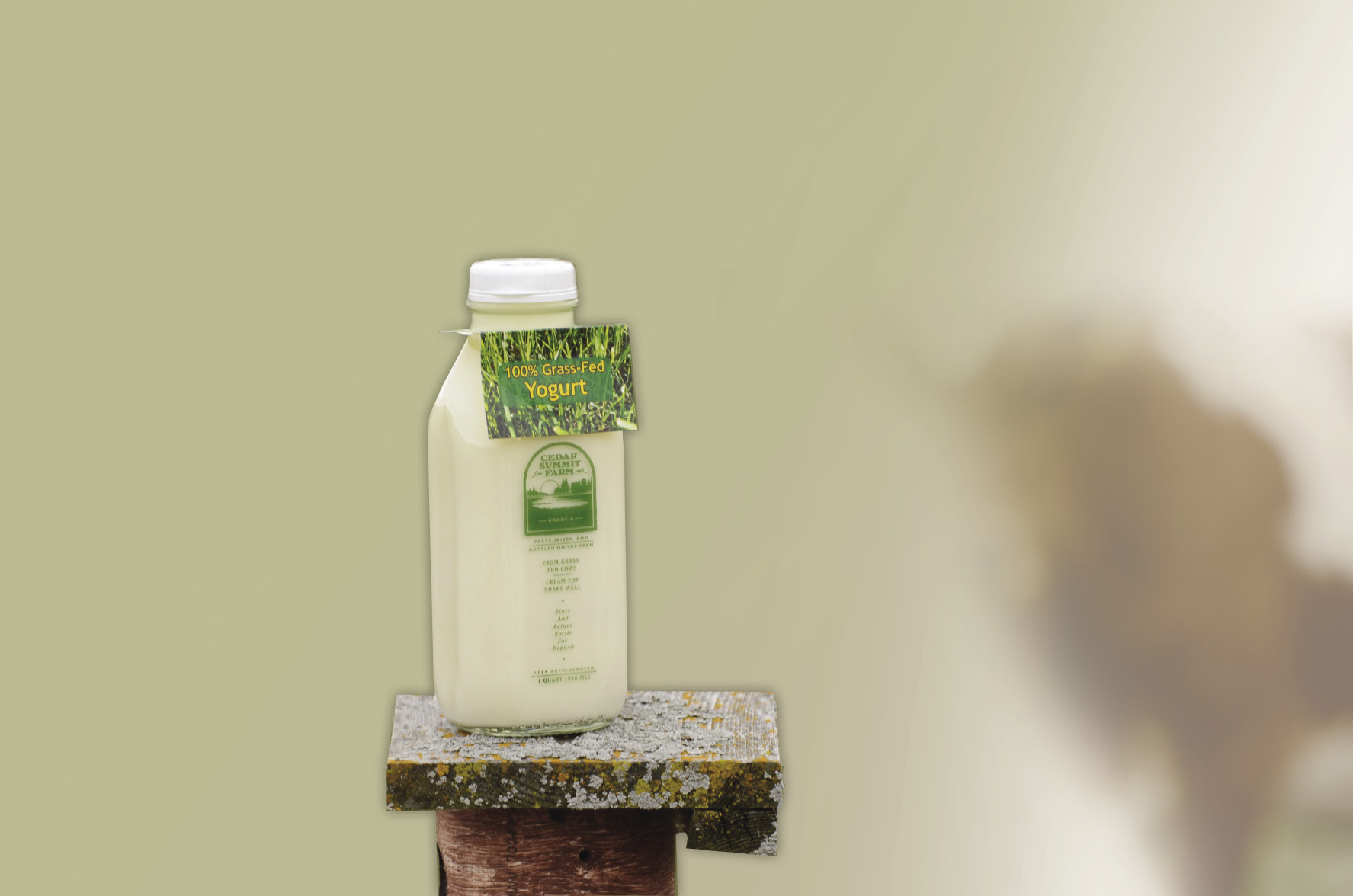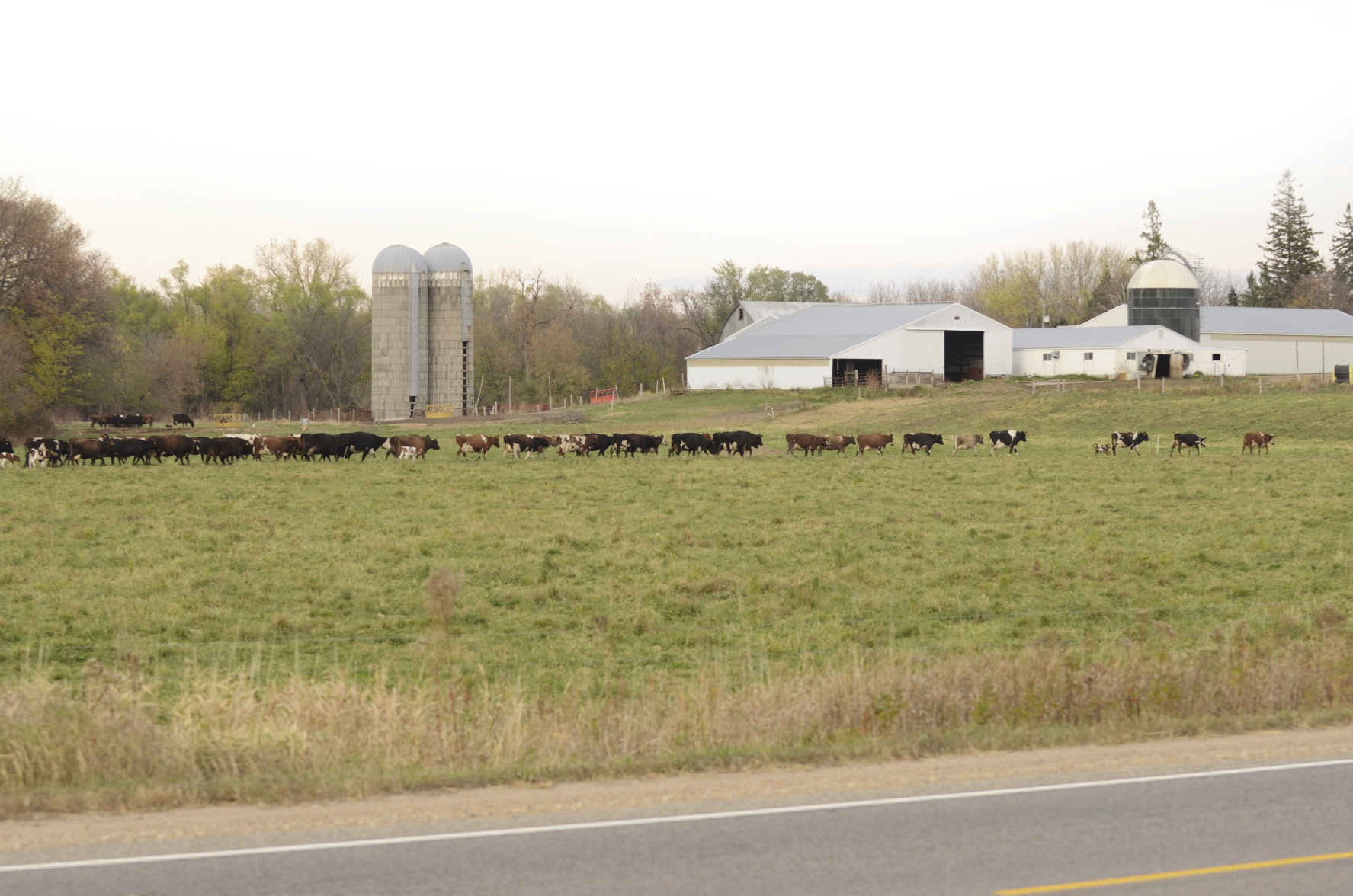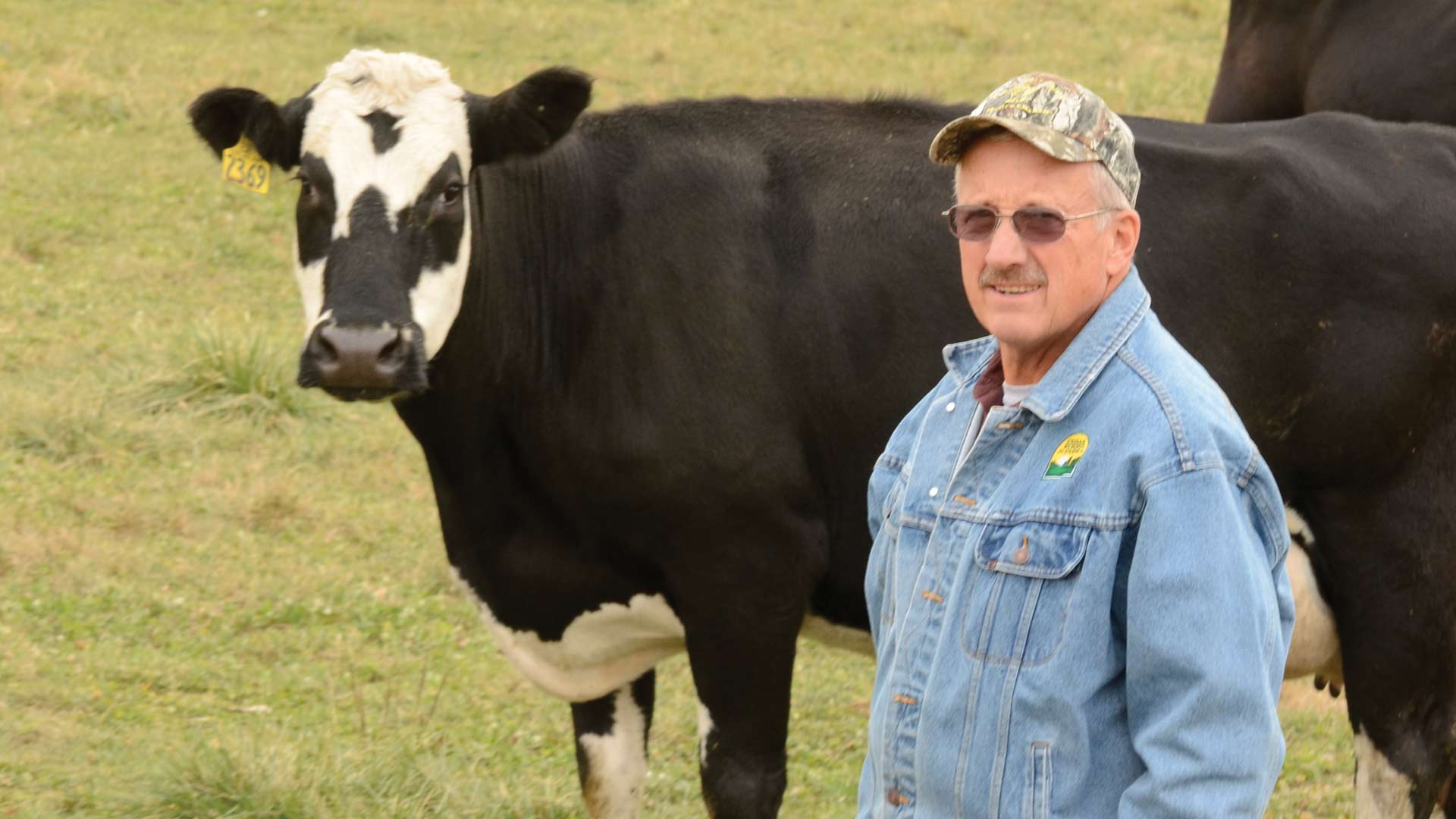New Prague, Minn. — Consumers who love their probiotics may be smiling with thick, white mustaches.

A new drinkable yogurt has been released by Cedar Summit Farm, a fourth-generation family business in southeast Minnesota. The creamy beverage is available in tangy-plain and lightly-sweetened vanilla flavors in quart-size glass returnable bottles.
“It’s just delicious,” says AURI food scientist Charan Wadhawan, who recently completed a nutritional analysis of the new product. “And it’s good for you … It’s easier to digest than milk because it’s fermented.”
The yogurt drink is produced from grass-fed, organic, non-homogenized whole milk, with added live and active cultures. Cedar Summit Farm makes it at one of the few remaining on-farm creameries in the Midwest. The family business, managed by Dave and Florence Minar and their son Mike, includes an on-farm store that markets a variety of local products, along with Cedar Summit Farm milk, cream and yogurt.
The creamery processes 300 to 400 gallons of milk per day from dairy cows grazed outdoors for seven months. After plants go dormant in the fall, cows are fed stored grass for five months.
Beverage of choice
Before developing the drinkable yogurt, Cedar Summit tried other value-added products, such as ice cream and dips. But, with market research and business plan assistance from USDA-funded Cooperative Development Services in Saint Paul, the family chose drinkable yogurt because of its “health benefits and the fact that there aren’t many organic drinkable yogurts in the market,” says Mike Minar, Cedar Summit’s business manager.

AURI helped fund product development and Dennis Timmerman, AUR project director, linked Minar to a University of Wisconsin dairy-food development service in River Falls.
After the yogurt recipe was perfected, Minar sent samples to AURI laboratories in Marshall where analytical chemist Ranae Jorgenson did a complete analysis. Wadhawan entered results into a database at AURI laboratories in Crookston and produced a nutritional label.
Cedar Summit Farm drinkable yogurt is a rich source of probiotics, Wadhawan says. The good bacteria in live cultures will digest milk proteins and produce lactase enzymes that break down some of the sugars, making milk easier to digest, she says.
“So people who are lactose intolerant — depending how intolerant they are — may be able to drink yogurt and not milk.”
Probiotics are especially important when taking antibiotics that kill good as well as bad bacteria, Wadhawan says, and they improve the digestive system’s ability to absorb calcium and B vitamins.
Starting slow

Cedar Summit Farm started marketing its drinkable yogurt in October. While the business sells its milk and cream products in about 50 food cooperatives and natural food stores, fewer than a dozen have added the drinkable yogurt so far. But “sales are slowly growing, and we’re working on a marketing campaign,” Minar says. Cedar Summit has hired a retired chef to give out in-store samples and promote the product’s merits “to get more people to try it,” Minar says.
In addition to vanilla and unsweetened plain flavors, Minar says he is working on a raspberry flavor that should be ready to market this summer. “It’s been difficult to locate an organic fruit source,” Minar says. “I thought we had found one and then it turned out their entire berry crop was under contract with another company.”
Minar says he doesn’t want to expand the product line too fast. “We’re just watching costs and trying to keep sales up.”
AURI & Cedar Summit Farm
Idea to Opportunity: Add a new product to Cedar Summit Farm’s organic, grass-fed milk and cream line produced at its on-farm creamery.
Outcomes: Drinkable yogurt was introduced to the marketplace in October. AURI assisted with product development, nutritional analysis and labeling.
Four generations of Cedar Summit farmers
Cedar Summit Farm’s drinkable yogurt joins a line of milk and cream products processed at a family-owned, on-farm creamery. Beside food co-ops and natural food stores, Cedar Summit markets its products in a retail store built on a farm that has been in the family for four generations.
The farm’s original 120 acres was purchased in 1926 by the grandparents of Dave Minar who, after graduating with a bachelor’s degree in ag economics and dairy science, started farming with his father in 1963. He then worked as a livestock breeder technician before returning to the farm in 1969 with his wife Florence and the first three of their
five children.
In 1971, the Minar family built a 60-stall cattle barn and started developing a registered Holstein herd that received state and national awards. In 1974, the Minars stopped using pesticides and, in the late 1980s, became interested in allowing animals to harvest their own feed for most of the year.
“The idea, which we found exciting, was that all of our land, some of which adjoins Sand Creek, would be in permanent pasture grasses and thus would stop erosion,” Dave Minar writes on the Cedar Summit website. “We could see how it would improve our quality of life with less feed to harvest.”
In 1994, the Minars built a milking parlor and decided to start a direct marketing business with 900 pasture-raised chickens. “Our chickens sold out and we were on our way,” Minar says. They decided to expand and first considered grass-fed beef. “After many family meetings the decision was made to process our own milk.”
In 2002, the Minars opened an on-farm creamery, which produces 300 to 400 gallons of milk daily from Cedar Summit Farm cows and a small neighboring dairy. The family also built a retail store that carries local eggs, honey, maple syrup, meat, cheese and butter, as well as Cedar
Summit products.
Today the Cedar Summit Farm business includes two farms — 200 acres in New Prague and 160 acres in McGrath, Minn. — and an additional 240 acres leased in southeast Minnesota. Most is pastureland for livestock grazing and the rest is seeded in grasses that can be harvested and stored for winter forage.
Today the farm no longer raises chickens but does raise steers and hogs, which “love the waste milk from the creamery,” Minar says. “It is a good feeling to be able to supply our community with high quality, fresh food.”
Right on the facts
The food marketplace may be hungry for new and different products. But it spits out more than it chews. When entering the market, food products have to be at their competitive best and meet all regulations, including labeling.
AURI food scientist Charan Wadhawan has been helping entrepreneurs develop, improve and commercialize new food products for three decades. The biggest demand for her service is nutritional analysis and labeling. Hundreds of aspiring entrepreneurs have requested this assistance so they can compete with giants on the food shelf.
What goes into developing a nutritional label? At a minimum, Wadhawan enters each of a food formula’s ingredients into an extensive database. But it’s not as simple as entering “flour.”
“If you say ‘all-purpose flour,’ there are so many and they can vary in protein content,” Wadhawan says. “If you are making bread, there is bread flour and, if cake, cake flour. There is a lot of protein difference between the flours.”
“When I input any ingredient, I pick out the right one from my database,” which includes all of the USDA’s data on products tested plus thousands more. Wadhawan’s database includes more than 30,000 ingredients — from a wide range of manufacturers and locations.
“USDA data is based on products from different regions of the country and averaged out,” Wadhawan says. “But product purchased in Texas and Minnesota could be slightly different.”
Exact details
The more specific the information that goes in, the more accurate the nutritional report will be. “If (a food business) says ‘ketchup,’ I don’t know if they will be sticking with one brand, so I will use the standard values for ketchup. Otherwise I use the specific brand and tell them that if they change, it is their responsibility to change the nutritional facts.”
Typically, Wadhawan also analyzes moisture content because ingredients can lose moisture when processed, along with nutrients. “If a product contains vitamin C and it’s cooked, most of it is destroyed by heat.”
Some products do not have to be analyzed on every count. For example, Wadhawan knows that some ingredients do not contain fiber. And if it’s a vegetable product, “we know that cholesterol only comes from animal sources,” she says.
After all ingredient information is entered, a serving size is determined and the software system will compile a nutritional report. Wadhawan then prints a nutritional label that can be reproduced on product packaging.
A closer look
Some products’ nutritional analysis takes a little more digging. “If we’re not sure of their process, or loss of fat or moisture, then I need to get the actual analysis done on a product sample,” Wadhawan says.
If it’s a new product, Wadhawan has AURI analytical chemist Ranae Jorgenson do laboratory tests. In the case of Cedar Summit Farm’s drinkable yogurt, “we wanted to see if there was any difference between grass-fed milk and the data provided by the USDA on regular milk.” Results showed it was close to the same.
“Some prepared products — Mexican tamales, for example, go through a process of cooking corn certain ways. There are so many processing steps, and it’s hard for me to know completely how each was done. So I will get a complete analysis of the tamale,” Wadhawan says. “I also use the recipe and do the database analysis to make sure the data matches.”
Products such as smoked meat may lose fat while being processed. “We can’t guess how much, so I will have Ranae run the fat and cholesterol analysis” on the final product, Wadhawan says. After using a solvent extraction, Jorgenson measures the fat content.
Most analysis, including moisture, protein, fat and carbohydrates, can be done in AURI laboratories. Fiber content has to be measured by outside labs. “We use various standardized methods for each analysis,” Wadhawan says. “They are approved by the Association of Official Analytical Chemists.”
